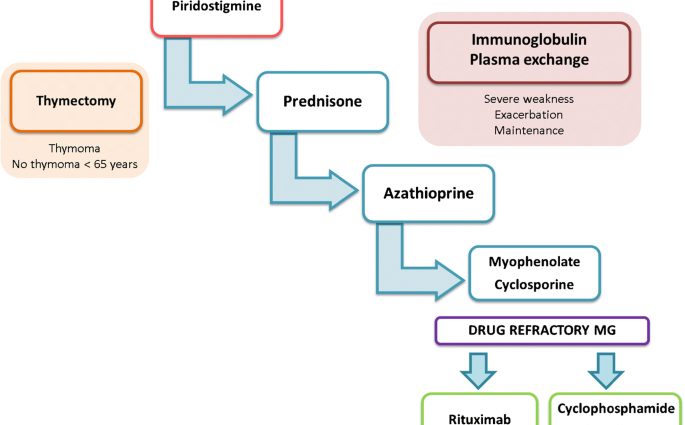Treatment of myasthenia gravis
Doctors use a variety of treatments, alone or in combination, to relieve symptoms of myasthenia gravis.
Medication
- Cholinesterase inhibitors. These drugs (eg neostigmine) improve communication between nerves and muscles by blocking the breakdown of acetylcholine. These drugs do not cure, but they can improve muscle contraction and strength. Possible side effects include gastrointestinal upset, nausea, excessive salivation, and sweating.
- Corticosteroids. Corticosteroids suppress the immune system, limiting the production of antibodies. They are mainly used in the treatment of ocular myasthenia gravis. Prolonged use of corticosteroids, however, can lead to serious side effects, such as weak bones, weight gain, diabetes, and an increased risk of infections.
- Immunosuppressants. These are drugs that modify the immune system. Side effects of immunosuppressants can be serious and include nausea, vomiting, gastrointestinal upset, increased risk of infections, liver damage, and kidney damage.
Intravenous treatment
- Plasmaphérèse. This procedure uses a filtering process similar to that of dialysis. The blood is passed through a machine that removes the antibodies. However, the beneficial effects usually only last a few weeks.
- Immunoglobulin. This therapy provides the body with normal antibodies that enhance the response of the immune system. However, it takes about a week to see the effects, and the benefits usually don’t last more than three to six weeks. The side effects are minor.
- Monoclonal antibody. Rituximab is a medicine that is used in some cases of myasthenia gravis.
surgery
About 15% of people with myasthenia gravis have a thymus tumor. Doctors will then perform surgery to remove the thymus (thymectomy). If there is no tumor, surgery can nonetheless decrease the symptoms of myasthenia gravis. The improvement is most often manifested several months after the operation.
The choice of treatments depends on several factors such as the age of the patient, the severity of their condition, the type of muscles affected and other co-occurring diseases.
Complementary approach
A small study suggests that intramuscular injection of huperzine A maintains muscle strength in patients with myasthenia gravis after 10 days of treatment. This effect is similar to that seen with neostigmine (an acetylcholinesterase inhibitor). Further larger studies are needed to confirm these results.










